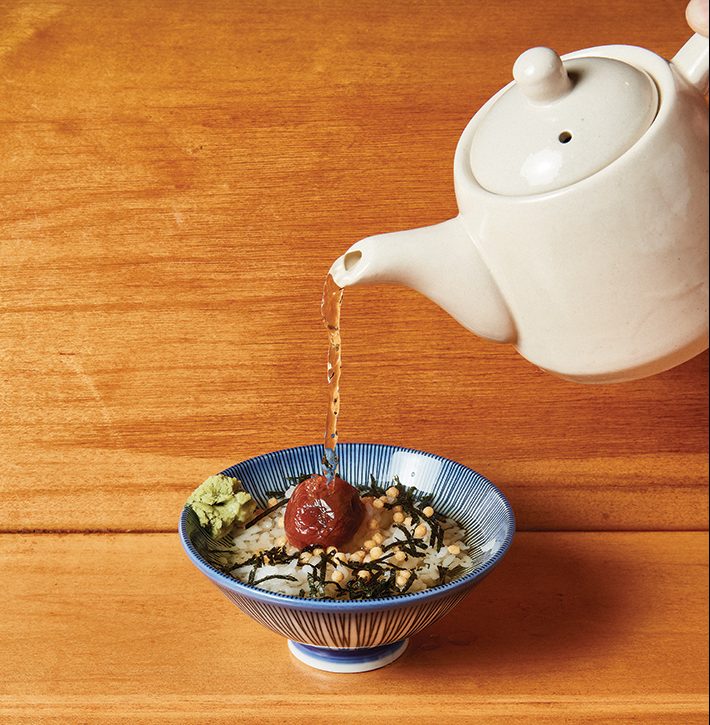Editor’s note: Miyoshi closed August 28, 2021.
One of my favorite books, by Junichiro Tanizaki, is a long essay on the Japanese sense of beauty. Called In Praise of Shadows, he touches on everything from architecture to the cloudiness of a bowl of soup. “It has been said of Japanese food that it is a cuisine to be looked at rather than eaten,” Tanizaki writes. “I would go further and say that it is to be meditated upon, a kind of silent music evoked by the combination of lacquerware, the light of a candle flickering in the dark.”

Photograph by Jeremy Kramer
Even with electric lights—turned quite low, of course—some of this quality remains at Miyoshi. Where other great restaurants in Cincinnati aim to be bustling and exciting, Miyoshi is calm, from the raked sand of the rock garden on either side of the entrance ramp to the flavors in the food. Yakizakana, for example, is just a piece of grilled fish—we chose the mackerel—served with a piece of lemon, a spoonful of grated daikon radish, and a seaweed salad dressed with toasted sesame oil. Every element of the dish has a certain distance from the others, both visually, on the plate, and on the palate: the mild, watery spiciness of the radish; the sweet roundness of the sesame and seaweed; and the strong, oily taste of the fish (brightened with lemon juice).

Photograph by Jeremy Kramer
The dish is simple, but—like so much at Miyoshi—it is also a kind of perfection. The simplicity and clarity is precisely what I miss in most American food. And this is just the kind of dish left off the menu in most Japanese restaurants.
For too long, Japanese cuisine in America has meant miso soup, sushi and sashimi, and various grilled meats with teriyaki sauce. Yes, you can get excellent versions of all of these at Miyoshi, but what makes this restaurant truly special is the revelation of the true panorama of Japanese cuisine. From ochazuke (tea soup) with umeboshi (a salty-sour pickled plum) to shime saba, marinated mackerel in a delicately pickle-y broth of cucumber and vinegar, there are a dozen items I have never seen elsewhere.
The menu is long and can be slightly confusing. From the kinoko itame to the cha soba, even with the menu description, I had little idea what to expect. Would I actually enjoy it, or find it strange and incomprehensible?

Photograph by Jeremy Kramer
The answer: Be adventurous, because almost everything is wonderful. Anyone who enjoys sushi or miso broth has built the foundation to appreciate the rest of this cuisine. Cha soba was green tea noodles with shredded seaweed, chopped scallions, and a sweet and soupy broth. It had a satisfying umami note, even served cold, and a pleasing bite when wasabi was mixed in. The kinoko itame was sauteed shiitake and enoki mushrooms, surprisingly buttery and sweet, showing a voluptuous quality rarely associated with this tradition, but a perfect counterpoint to the more austere offerings.
Mediocre sushi often leans on sticky rice and a kind of monotonous but satisfying flavor note, dunking what is basically a rice ball in soy sauce. With a smear of wasabi and pickled ginger, every bite basically ends up tasting the same. At Miyoshi, the rice under the sashimi is just a tiny bite, hidden beneath the fish, and a thin circle around the rolls. Every piece of seafood is absolutely fresh, far from the papery white sheath and faded pink of aging tuna found in grocery store sushi. The ginger is not dyed pink (it’s yellow—that is, the actual color of ginger), and the fish are of such vibrant rainbow hues that you hesitate to douse them with soy sauce. There is such a sense of balance and restraint in each preparation that it would be a shame to wipe out the distinctions. Apply condiments with the same care that the chef has assembled the dish, and you will taste what makes Miyoshi different.

Photograph by Jeremy Kramer
Tanizaki describes the trance that a really beautiful soup can produce. Miyoshi’s Japanese clientele—usually about half of the diners at any given meal—gravitate toward the large meal soups with udon, soba, and ramen noodles in a variety of broths. I tried the ramen, at the server’s suggestion. Anyone who has ever eaten a packet of the instant stuff—I hesitate to even compare the two—can feel the new depths in a bowl of Miyoshi’s pork broth. One seems to transmit health and serenity; the other manages to do the opposite.
The staff at Miyoshi happily shares their enthusiasm. The server told me about the particular form of shiso (in the mint family) they use on their sashimi plate (one variety of this plant grows wild across most of the mid-Atlantic, but the leaf Miyoshi uses tasted very different, with a curry leaf-and-cumin note). Another server helped my young son rig up his chopsticks with a rubber band and a folded paper so he could use them more easily.

Photograph by Jeremy Kramer
This little encounter might serve as a kind of metaphor for doing traditional cuisine well. Don’t give people exactly what they are used to—a fork, for example, or yet another California roll—but help them on the path to understanding the real thing, even if it’s unfamiliar at first. Much of it is not so unfamiliar after all: As I was eating the gyu don, a dish of shredded beef with ginger, I found slices of burdock, with a lovely, woodsy flavor. Burdock, like shiso, grows wild all around Cincinnati, just waiting for us to discover it.
If you have even a passing fondness for Japanese cuisine, you owe it to yourself to try Miyoshi. It is one of our treasures.
Miyoshi, 8660 Bankers St., Florence, (859) 525-6564




Facebook Comments